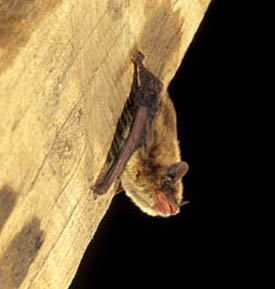
Description:
-
Weight: 1/4 - 1/2 oz. (6-13 g)
-
Body length: 3 - 3 7/8 in. (75-99 mm)
-
Wingspan: 10-11 in. (26-29 cm)
-
Forearm: 1 1/4 - 1 5/8 in. (31-40 mm)
The evening bat is a small bat with dark brown fur, and black on its ears, wings, and tail. Evening bats have relatively short ears and a blunt tragus which separates them from other similar species. Evening bats also have a pungent odor.
Evening bats are have medium to fast, erratic flight patterns but will occasionally fly slow.
Roosts:
-
Summer Roost: Evening bats may roost in large colonies in buildings, or in smaller colonies under loose bark or within hollow trees.
-
Winter Roost: The winter habits of evening bats are relatively unknown. It is thought that they may migrate south during the winter, but some may hibernate in hollow trees or under bark in Maryland.
Diet:
Moths, beetles, flies and flying ants.
Similar Species:
- Big brown Bat resemblance, but smaller.
- Blunt tragus separates it from the myotine bats.
Conservation:
Evening bats are listed as
species of greatest conservation need in Maryland.
Sounds:
Echolocation Frequency: 35-75 kHz
Photo by: Dr. J. Scott Altenbach
Return to Field Guide to Maryland Bats